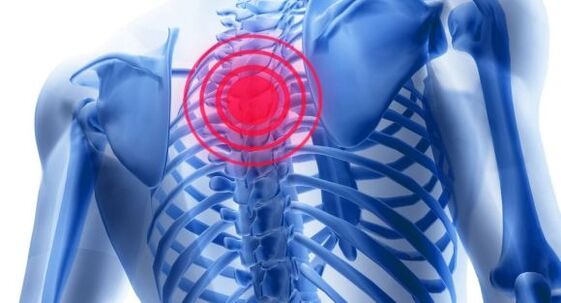
Thoracic osteochondrosis- This is a dystrophic change in intervertebral discs, located in the thoracic column.It is required that the treatment of the disease will begin immediately after making a diagnosis, since the disease can quickly enter a chronic form.
The main symptoms of the disease are the limitation of the mobility of the shoulder girdle, the lack of breath, the discomfort in the stomach and the pain in the chest that yields in the heart.The danger to the patient is that the symptoms of osteochondrosis are often confused with cardiovascular diseases, therefore, therapy is carried out by incorrect disease.
The causes of osteochondrosis
Thoracic osteochondrosis occurs as a result of pathological changes in vertebrae and intervertebral discs, as well as blood supply and blood nutrition.In addition, the disease can be caused by the deformation of the spine.
Especially, people who are in a sedentary position suffer the symptoms of breast osteochondrosis.Basically, these are office workers and students of different ages.Due to the constant session without observing the correct position of the body, the load in the vertebrae increases significantly, which causes its deformation.
The root causes of the disease:
- Increase in the column load that occurs when we lift weights
- Changes related to age in the body
- overweight
- ESPINAL DEPARTMENT INJURIES
- predisposition at the genetic level
Depending on the symptoms stage, it is divided into 2 clinical cases.In the first case, pain suddenly appears and has an acute form (the "lateral" called).In the second case, pain is long and is often accompanied by stiffness in the cervical and thoracic column.The pain for breast osteochondrosis limits the mobility of the back, and also causes difficulty breathing.
The treatment of osteochondrosis of the thoracic region is carried out using complex methods and schemes, whose compilation depends on the stage of the disease, its course and causes.Only a highly qualified specialist can deal with this task.
Stages of the disease
The first stageIt is characterized by the appearance of local pain due to muscle weakening (thoracalgia).In addition, in the first stage there is a tension of the paravertebral muscles of the back, which leads to greater pain and limits the mobility of the spine.
The second stageIt is accompanied by an increase in pain syndrome, since nerve roots are involved in the inflammatory process.Also at this stage, the protuberance and/or hernias of the intervertebral discs (MPD) appear.
The third stageIt causes constant pains that occur in the affected nerve area.There is a change in march, numbness in the limbs, the appearance of headaches, difficulty breathing and failure of heart rate.This is due to the manifestation of significant deformations of the intervertebral disc and the spine.The risk of kidnapping increases sharply (kidnapping is the separation of hernia and its movement along the spine, which damages the nerve roots associated with the spinal cord).And this in 90% of cases leads to surgery.
InFourth stageDiseases interrupt the functions of the intervertebral disc.The bone growth of the vertebral bodies begins to connect the nearby vertebrae between them.The osteochondrosis of the column often causes a violation of the blood supply to the spinal cord.This stage of the disease is the most dangerous, since without timely therapy leads to disability.
Treatment
Before continuing with the treatment, the diagnosis is carried out to detect the stage of the disease (initial, acute or chronic).Depending on existing symptoms, therapy methods are selected.
The treatment of osteochondrosis of the thoracic region is more effective in the initial stages, when pathological changes are not so clearly expressed and reversible.
The main sign that the disease has gone to the acute stage are the incessant painful sensations;Back, chest and spine muscles.At this stage in the development of osteochondrosis, the doctor's priority task is to relieve pain.













































